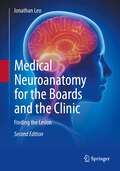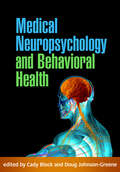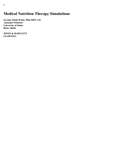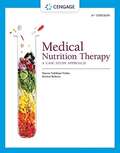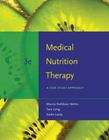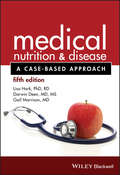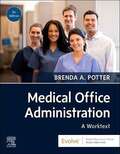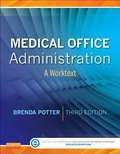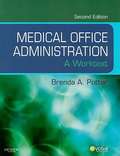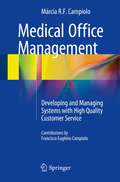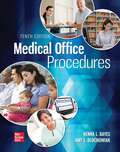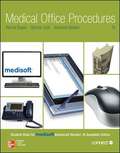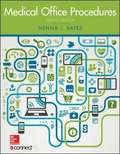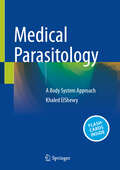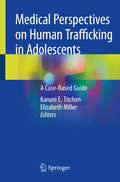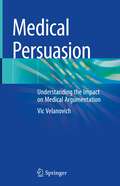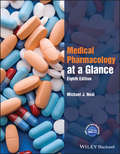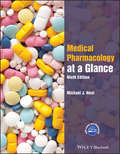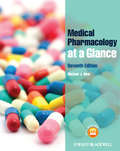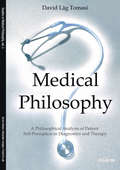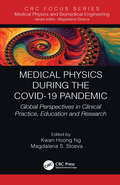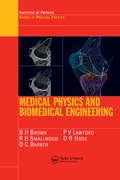- Table View
- List View
Medical Neuroanatomy for the Boards and the Clinic: Finding the Lesion
by Jonathan LeoThis second edition title provides medical students and residents with the information to build skills that will aid them in studying for any level of their board exams. It also prepares students with the ability to look at a patient’s neurological signs and symptoms, logically think through the various tracts, and determine where a lesion is located.This 2nd edition book is a systematic approach to learning neuroanatomy by studying various lesions to the nervous system and their subsequent signs and symptoms. If you are a medical student, this is not the time for simply memorizing a list of symptoms that go along with the name of a syndrome. Forget memorizing random isolated factoids with a series of flash cards. This is the point in your education when you need to understand the lesion scenarios. To do this you need to put everything together and develop a big picture view of the nervous system. When you can do this, then the details will make a lot more sense. With that said, everything that follows in the text is related to clinical scenarios. Fully updated and greatly expanded with content (including a neuroanatomy atlas) this unique and comprehensive textbook received outstanding reviews in the first edition. Including 100 high-yield neuroanatomy key phrases and a cross section of images with lesion test questions, this title specifically fills a gap in the literature for medical students studying for their board exams and those about to go on a neuro-related rotation. Written by a renowned professor with over 25 years of teaching experience specific to board exam preparation, chapters are crafted with the goal of aiding students in understanding concepts by explaining the reasoning behind signs and symptoms, rather than pure memorization.Medical Neuroanatomy for the Boards and the Clinic, 2nd edition, is the go-to book for students seeking a practical yet nuanced reference for board exam preparation.Provides 100 high-yield neuroanatomy key phrasesFeatures cross section images with lesion test questionsWritten with the medical student in mind who is studying for board exams
Medical Neuropsychology and Behavioral Health
by Cady Block Doug Johnson-GreeneIt is increasingly recognized that medical conditions can have a range of neurocognitive, psychosocial, and functional implications, even in the absence of obvious neurological involvement. Filling a gap in the literature, this comprehensive clinical reference reviews current research and provides clear guidelines for assessment and intervention. Chapters organized around major bodily systems--for example, cardiovascular, endocrine, immune/lymphatic--probe neurocognitive impairments associated with prevalent health conditions and their treatments, including coverage of COVID-19. State-of-the-science chapters on lifestyle behaviors and habits explore the neurocognitive impact of sleep and fatigue, nutrition and weight, acute and chronic pain (and the use of opioid analgesics), personality and temperament, and substance misuse.
Medical Nutrition Therapy Simulations
by Seanne Safaii-WaiteThrough a combination of simulated medical records and online decision-tree modules, Medical Nutrition Therapy Simulations guides students through clinical experiences that allow them to practice their critical thinking skills. These simulations acclimate students to the routine and rigors of the average clinical rotation in which they’re expected to do all of the following: conduct a complete nutrition assessment of a patient, collect, analyze, and interpret data, set priorities for nutrition care plans, and document conclusions about complex problems <p><p>The 10 simulation scenarios included in this text outline the details of cases relating to congestive heart failure, diabetes, liver disease, and other critical conditions. These simulations can be used in role-play activities with preceptors or with actors, as well as with high- or low-fidelity simulation robots. Each new copy of this text also includes access to 10 online decision-tree modules that are focused on the same topics as the in-text simulation scenarios. In these decision-tree modules, each decision the student makes impacts the outcome of the patient’s treatment, encouraging the student to improve their ability to make decisions effectively and reliably. <p><p>A comprehensive resource unlike anything currently available, Medical Nutrition Therapy Simulations provides a perfect environment to practice and prepare for clinical rotations. Each new copy of Medical Nutrition Therapy Simulations is accompanied by an access code that unlocks 10 decision-tree modules that cover the following topics: Celiac disease, Congestive heart failure, Chronic obstructive pulmonary disease, Type 1 diabetes mellitus, Type 2 diabetes mellitus, Liver disease, Lung cancer, Pancreatitis, Renal failure, and Wound care These modules mimic real-life clinical situations in which choices or outcomes of treatment are uncertain and are determined by the choices made by the practitioner. Each module features three decision points that determine the final outcome for the patient.
Medical Nutrition Therapy: A Case Study Approach
by Marcia Nelms Kristen RobertsPrepare for clinical practice by "solving" 29 realistic case studies in nutrition and medical nutrition therapy. Using the medical record as its structure, you draw on the information provided (hospital admission data, laboratory test results, intake/output records, and physician and other health care provider progress notes) to solve the case. A series of questions follow the case, focusing on pathophysiology; assessment; clinical, nutritional, and behavioral outcomes; interventions; and appropriate follow-up for the patient.
Medical Nutrition Therapy: A Case Study Approach (3rd edition)
by Marcia Nelms Karen Lacey Sara Long RothThis casebook is composed of 32 realistic nutrition and diet therapy case studies that each use the medical record as its structure. The reader "solves the case" by using the information provided such as hospital admission data, laboratory reports, and physician's narrative. The case is followed by a series of questions and applications that focus on pathophysiology, assessment, clinical, nutritional and behavioral outcomes, interventions, and appropriate follow-up for the patient. This "real world" approach helps to prepare the reader for the professional setting. Objectives for learning within each case are built around the competencies for dietetic education as specified by the American Dietetic Association.
Medical Nutrition and Disease
by Darwin Deen Lisa Hark Gail MorrisonMedical Nutrition and Disease: A Case-Based Approach is an ideal way for medical students, physician assistant students, dietetic students, dietetic interns and medical residents to advance their nutrition knowledge and skills. Dietitians in clinical practice and dietetic educators will also benefit from the updated nutrition concepts and case-based approach.The 5th edition of this best-selling text has been fully updated and includes 13 chapters and 29 cases, with 6 brand new cases covering many of the scenarios faced in everyday clinicians practice. The text is a practical guide to the role that nutrition plays in disease prevention, treatment and management and also provides 48 self-study continuing education credits for dietitians. Medical Nutrition and Disease:* Features learning objectives and current references in every chapter and case.* Teaches you how to diagnose and manage nutritional problems, integrate nutrition into clinical practice, and answer your patients' most common questions.* Includes nutritional advice for specific patient groups, such as children, teenagers, pregnant women, and older adults. * Includes contributions from nationally recognized nutritionists and physicians who teach nutrition in medical schools, and undergraduate and graduate dietetic programs.Registered dietitians can earn 48 C.E. credits from the Academy of Nutrition and Dietetics by successfully completing the updated multiple choice questions included in the book. Everything has been pre-approved by the Commission on Dietetic Registration and there are no additional fees.
Medical Office Administration
by Brenda A. Potter BS CPC-I CPCLearn the skills you need to succeed in the modern medical office! Medical Office Administration: A Worktext, 5th Edition provides a clear, hands-on approach to help you master the role and responsibilities of the administrative medical assistant. With a focus on exceptional patient service, this easy-to-read text stresses comprehension, application, and critical thinking to ensure you are job-ready on Day 1. <p><p>When used in conjunction with SimChart® for the Medical Office, Elsevier’s educational EHR (sold separately), you will gain realistic experience with day-to-day tasks as if you were in an actual office setting.This worktext helps you develop the knowledge and skills you need to think critically and respond confidently to the challenges you’ll encounter on the job.
Medical Office Administration, Third Edition
by Brenda A. PotterMedical Office Administration, Third Edition, explores the career of a medical administrative assistant, beginning with an examination of the profession and the health care industry, and continuing on to the daily responsibilities of a medical administrative assistant. The text is organized into five units and 16 chapters which are designed to prepare the student for employment as a medical administrative assistant.
Medical Office Administration: A Worktext
by Brenda A. PotterUsing a clear, hands-on approach to learning front office skills, Medical Office Administration, 4th edition prepares you for a successful career as an administrative medical office assistant. Performing procedures with SimChart® for the Medical Office (SCMO), you'll practice day-to-day tasks as if you were in an actual office setting. This new edition adds updated content to support use of the electronic health record, new Affordable Care Act information, Insurance/Billing/Coding content, and SCMO activities woven throughout the text. Covering administrative tasks from appointment scheduling to medical billing, this work text helps you develop the knowledge and skills you need to think critically and respond confidently to the challenges you'll encounter on the job.? A conversational writing style makes it easier for you to read and understand the material. Stopping points provide you with thought-provoking questions or activities to break up the narrative in manageable segments. HIPAA Hints ensure that you comply with HIPAA mandates. Real-world examples apply important concepts to the medical office setting. Interactive electronic procedure checklists spell out the individual steps required to complete a full range of administrative procedures, and are based on CAAHEP competencies. NEW! SimChart® for the Medical Office (SCMO) throughout text allows you to practice common administrative tasks with real-world office management software. NEW! Coverage of the Affordable Care Act and ICD-10 prepares you for what you'll encounter on the job. NEW! Medical Assisting mapping tables tie into CAAHEP and ABHES competencies. NEW! High-quality illustrations and updated screenshots helps reinforce content.
Medical Office Management
by Márcia R. F. CampioloThe present book aims to assist and guide medical doctors in any specialty to manage his/her own clinic or office, allowing a higher and better development of its team/staff and providing tools for a high quality service to patients and customers. It is devoted to be the background for any medical doctor's success in personal career, serving as a foundation for professional growth. In last instance, Medical Office Management is intended to be a practical manual for easy day to day application in medical clinics.
Medical Office Procedures
by Nenna L. Bayes Amy L. BlochowiakMedical Office Procedures (MOP) provides the required background for the responsibilities of the administrative medical assistant. It is a text-workbook that introduces and describes the tasks of a medical office assistant's career; teaches records management, medical communications, and scheduling skills; and describes procedures for preparing patients' charts and bills. Practice management, electronic health records, managerial skills, and finances are also addressed.
Medical Office Procedures (7th Edition)
by Nenna L. Bayes Bonnie J. Crist Karonne J. BecklinThis seventh edition of Medical Office Procedures (MOP), the long-awaited revision of this widely used textbook, provides the required background for the responsibilities of the administrative medical assistant. To prepare students for the ever-increasing use of technology in the medical office, this revision places continued importance on the computerization of routine tasks and of communications.
Medical Office Procedures 8th Edition
by Nenna L. BayesThoroughly revised and updated, Medical Office Procedures is a text-workbook that introduces and describes the tasks of a medical office assistant's career; teaches records management, medical communications, and scheduling skills; and describes procedures for preparing patients' charts and bills. Practice management, electronic health records, and finances are also addressed. Multi-day simulations provide real-world experience with physician dictation. Managerial skills are also included.
Medical Parasitology: A Body System Approach
by Khaled ElShewyThis book offers a concise and clear overview of medically important parasites. It sets itself apart from traditional parasitology systematic books by adopting an integrated modular system, which is currently being introduced in many countries. Parasites are categorized based on the body systems they infect. To avoid repetition, parasites with multisystem effects are grouped under the system they primarily infect, and they are cross-referenced in other relevant sections. The book thoroughly covers the various stages of a parasite's life cycle, modes of transmission, epidemiology, and diagnosis of parasitic diseases. To foster a better understanding of the connections between basic and clinical subjects, the text emphasizes the pathogenesis and subsequent clinical presentation of commonly encountered parasitic infections in humans. Moreover, the text includes current information on the ever-changing field of anti-parasitic treatment, serving as a valuable resource for practitioners. Each section is accompanied by endnotes that highlight key points, and review questions are provided to facilitate comprehension and review. The book's original drawings, tables, and colored diagrams are designed to simplify the understanding of pathogenesis and structural morphology. For those seeking additional details, structural morphology and dosages of anti-parasitic drugs are presented. The language is straightforward, making the book suitable for medical students and physicians alike, enabling them to approach more simplified literature with confidence. Additional questions and answers via app: Download the Springer Nature Flashcards app free of charge and use exclusive additional material to test your knowledge.
Medical Parasitology: A Self-instructional Text
by Ruth Leventhal Russell F. CheadleRely on this concise, systematic introduction to the biology and epidemiology of human parasitic diseases. Explore an extensive series of photographs, line drawings, and plates that aid in the recognition of medically-relevant parasites and help to build a solid understanding of the fundamentals of diagnosis and treatment.
Medical Parenting: How to Navigate Health, Wellness & the Medical System with Your Child (Medical Parenting Ser. #1)
by Jacqueline JonesMedical Parenting is the essential guide for parents to take control of their child&’s health, from choosing a pediatrician to helping children transition into adulthood.As one of America's Top Doctors™, a mother of two grown children, and a physician and surgeon with over 25 years&’ experience, Dr. Jones understands that there is no greater responsibility as a parent than ensuring your child's optimum health. With so much information out there, it can be hard to navigate the medical system. Medical Parenting walks parents through a myriad of scenarios involving children&’s health, from choosing that first pediatrician to chronic illness and surgery to nutrition and binge drinking in teenagers, so parents feel confident in their decisions and learn self-care along the way. More than just a medical system how-to, Medical Parenting is told from a physician and mother&’s perspective to include heartfelt stories from Dr. Jones&’ own journey of self-discovery. Dr. Jones helps parents connect with their children on a personal level as they grow towards adulthood and find their way through the maze of the medical system today.
Medical Perspectives on Human Trafficking in Adolescents: A Case-Based Guide
by Elizabeth Miller Kanani E. TitchenHuman trafficking is an increasingly large issue in medicine, particularly for the adolescent population. The pubertal and neurologic development of early- and mid-adolescence may serves as a foothold for trauma bonds and human trafficking. To date, there are few case studies of human trafficking in the medical literature. More often, these cases are missed, and human trafficking patients are unlikely to disclose their victimization to their physicians for multiple reasons. As a result, physicians fail to ask key questions and fail to notice important red flags for human trafficking. Research shows that this is primarily due to a lack of medical training and awareness and a resultant denial on the part of many physicians that victims of human trafficking present to their clinics or specialties.This book provides clinicians with a case-based guide to scenarios they may encounter in their practice that involve human trafficking. These cases include those involving sex trafficking and labor trafficking; male and female and transgender victims; victims from a range of racial, ethnic, geographic and socioeconomic backgrounds; as well as presentations of adolescent and young adult victims to fields such as adolescent medicine, general pediatrics, neonatology, rheumatology, transplant medicine, and obstetrics-gynecology, in addition to the stereotypical presentations to emergency departments. Each case is followed by a discussion that highlights key aspects of human trafficking in adolescent and young adult patients. These discussions also reference the growing body of research on human trafficking, orient the reader to medico-legal aspects of reporting human trafficking in the adolescent and young adult populations, and feature useful questions, exercises, and resources to promote discussion among those medical professionals who interact with adolescent medicine and young adult patients. Written by physicians, legal advocates and lawyers, Medical Perspectives on Human Trafficking in Adolescents is the definitive guide for all clinicians who care for adolescent patients. It is also a useful resource for mental health professionals and social workers.
Medical Persuasion: Understanding the Impact on Medical Argumentation
by Vic VelanovichThis unique book is a major contribution to the literature on persuasion in communication, and on doctor-patient communication, in particular. Written by a physician-scientist with deep experience on the topic, the book offers a comprehensive analysis of what makes an argument in medicine persuasive, outlining the characteristics of an argument that causes people to accept that the conclusion(s) of an argument are true. Although the book focuses on medical arguments in particular, the general approach offered by the author is appropriate for any informal argument. The central emphasis is that although sound logical construction and true premises are required to establish the logical truth of a conclusion, this is insufficient for persuasion to occur. Although formal logic can exist independent of human reception, real-world arguments must have both an arguer (the individual constructing the argument) and an audience (individuals listening and evaluating the argument). Whether the audience is capable of changing their world view is as important as the logical construction of the argument, maintains the author. To illustrate all points, a plethora of examples in medical research and in diagnosis and treatment decisions are presented. Medical Persuasion: Understanding the Impact on Medical Argumentation is a unique contribution to the clinical literature and will be of immense interest to medical practitioners, researchers, and philosophers as a way of gaining insights into constructing arguments for their peers and patients. In addition, medical trainees will gain important insights in the production of medical knowledge and medical practices, and even students in the social sciences and humanities will find the work valuable as a conduit to gaining insight into the reception of an argument.
Medical Pharmacology at a Glance
by Michael J. NealWidely recognised as the best starting point for pharmacology study, the internationally best-selling Medical Pharmacology at a Glance is an ideal companion for all students of the health sciences. Key principles are supported by coloured schematic diagrams - invaluable as both an introduction to medical pharmacology, and revision in the run-up to pharmacology exams. Revised and thoroughly updated throughout, and reflecting changes to the content and assessment methods used by medical schools, Medical Pharmacology at a Glance: Introduces the basic principles of drug action, interaction, absorption and excretion Bases chapters on diseases and syndromes, for clinically-focused learning Includes references to the pathophysiology of disease, to aid understanding of drug choice and action Indicates the therapeutics of choice for specific disorders and conditions Features cross references between discussion of drug classes and diseases Includes self-assessment cases studies with full answers, for revision and review Features a new chapter on immunosuppressants and antirheumatoid drugs Now includes a brand new companion website, with cases and fully downloadable flashcards, at www.ataglanceseries.com/pharmacology
Medical Pharmacology at a Glance (At a Glance #69)
by Michael J. NealThe internationally best-selling Medical Pharmacology at a Glance is the ideal companion for all medical and healthcare students, providing a visual overview of pharmacology, and describing the basic principles of drug action, interaction, absorption, and excretion. Clear and accessible chapters organised around common diseases and conditions facilitate efficient clinical learning, and include references to drug classes and side effects, disease pathophysiology, prescribing guidelines, and more. Now in its ninth edition, this leading guide has been thoroughly updated to reflect current guidelines and drug information. This edition features new and revised illustrations, additional pedagogical tools, and enhanced online content. Widely recognised as both the best introduction to medical pharmacology and the perfect revision tool for USMLE and pharmacology exams, this invaluable guide: Covers a wide range of drugs used to treat conditions such as hypertension, anaemias, cancer, and affective disorders Explains drug mechanisms and the principles of drug action Discusses practical topics including drug misuse, drug indications, and side effects Includes a companion website featuring online cases, flashcards, and a list of core drugs
Medical Pharmacology at a Glance (At a Glance #70)
by Michael J. NealWidely recognised as the best starting point for pharmacology study, the internationally best-selling Medical Pharmacology at a Glance is an ideal companion for all students of the health sciences. Key principles are supported by coloured schematic diagrams - invaluable as both an introduction to medical pharmacology, and revision in the run-up to pharmacology exams. Revised and thoroughly updated throughout, and reflecting changes to the content and assessment methods used by medical schools, Medical Pharmacology at a Glance: Introduces the basic principles of drug action, interaction, absorption and excretion Bases chapters on diseases and syndromes, for clinically-focused learning Includes references to the pathophysiology of disease, to aid understanding of drug choice and action Indicates the therapeutics of choice for specific disorders and conditions Features cross references between discussion of drug classes and diseases Includes self-assessment cases studies with full answers, for revision and review Features a new chapter on immunosuppressants and antirheumatoid drugs Now includes a brand new companion website, with cases and fully downloadable flashcards, at www.ataglanceseries.com/pharmacology
Medical Philosophy: A Philosophical Analysis of Patient Self-Perception in Diagnostics and Therapy
by David Låg TomasiThis innovative book clarifies the distinction between philosophy of medicine and medical philosophy, expanding the focus from the 'knowing that' of the first to the 'knowing how' of the latter. The idea of patient and provider self-discovery becomes the method and strategy at the basis of therapeutic treatment. It develops the concept of 'Central Medicine', aimed at overcoming the dichotomies of Western-Eastern medicine and Traditional-Integrative approaches. Evidence-based and patient-centered medicine are analyzed in the context of the debate on placebo and non-specific effects alongside clinical research on the patient-doctor relationship, and the interactive nature of human relationships in general, including factors such as environment, personal beliefs, and perspectives on life's meaning and purpose. Tomasi's research incorporates neuroscience, psychology, philosophy, and medicine in a clear, readable, and detailed way, satisfying the needs of professionals, students, and anyone who enjoys the exploration of the complexity of human mind, brain, and heart.
Medical Philosophy: A Philosophical Analysis of Patient Self-Perception in Diagnostics and Therapy (Studies in Medical Philosophy #1)
by David Låg TomasiThis innovative book clarifies the distinction between philosophy of medicine and medical philosophy, expanding the focus from the 'knowing that' of the first to the 'knowing how' of the latter. The idea of patient and provider self-discovery becomes the method and strategy at the basis of therapeutic treatment. It develops the concept of 'Central Medicine', aimed at overcoming the dichotomies of Western–Eastern medicine and Traditional–Integrative approaches. Evidence-based and patient-centered medicine are analyzed in the context of the debate on placebo and non-specific effects alongside clinical research on the patient-doctor relationship, and the interactive nature of human relationships in general, including factors such as environment, personal beliefs, and perspectives on life's meaning and purpose. Tomasi's research incorporates neuroscience, psychology, philosophy, and medicine in a clear, readable, and detailed way, satisfying the needs of professionals, students, and anyone who enjoys the exploration of the complexity of human mind, brain, and heart.
Medical Physics During the COVID-19 Pandemic: Global Perspectives in Clinical Practice, Education and Research (Focus Series in Medical Physics and Biomedical Engineering)
by Kwan Hoong Ng; Magdalena S. StoevaSpreading to every corner of the Earth, the COVID-19 virus has had an unparalleled impact on all aspects of our lives. This book explores in detail how the COVID-19 pandemic has affected clinical practice, education, and research in medical physics, and how colleagues on the frontline dealt with this unpredictable and unprecedented pandemic. It tackles key questions such as: How did medical physicists first respond to the situation? What innovative strategies were taken and how effective were they? How are medical physicists preparing for the future? There will be a focus on the different experiences of regional medical physicists and the responses and outlooks in clinical practice, education, and research in the affected continents, Asia-Pacific, the Middle East, Europe, Africa and North and Latin America. With over 91 contributors from 39 countries, this unique resource contains key perspectives from teams from each territory to ensure a global range of accounts. The collective opinion and wisdom from the major medical physics journal editors-in-chief are also explored, alongside how the pandemic has affected the quantity and quality of publications. Voices of early-career researchers and students of medical physics will be included, with narratives of their experiences coping with life during the pandemic. Lastly, communicating leadership in times of adversity is highlighted. This book will be a historic account of the impact of the COVID-19 virus on the field of medical physics. It will be an ideal reference for medical physicists, medical physics trainees and students, hospital administrators, regulators, and healthcare professionals allied with medical physics. Key features: The first book to cover the impact of COVID-19 on the field of medical physics Edited by two experts in the field, with chapter contributions from subject area specialists around the world Broad, global coverage, ranging from the impact on teaching, research, and publishing, with unique perspectives from journal editors and students and trainees
Medical Physics and Biomedical Engineering (Series in Medical Physics and Biomedical Engineering)
by B. H Brown R. H Smallwood D. C. Barber P. V Lawford D. R Hose<p>Medical Physics and Biomedical Engineering provides broad coverage appropriate for senior undergraduates and graduates in medical physics and biomedical engineering. Divided into two parts, the first part presents the underlying physics, electronics, anatomy, and physiology and the second part addresses practical applications. The structured approach means that later chapters build and broaden the material introduced in the opening chapters; for example, students can read chapters covering the introductory science of an area and then study the practical application of the topic. <p>Coverage includes biomechanics; ionizing and nonionizing radiation and measurements; image formation techniques, processing, and analysis; safety issues; biomedical devices; mathematical and statistical techniques; physiological signals and responses; and respiratory and cardiovascular function and measurement. Where necessary, the authors provide references to the mathematical background and keep detailed derivations to a minimum. They give comprehensive references to junior undergraduate texts in physics, electronics, and life sciences in the bibliographies at the end of each chapter.</p>
